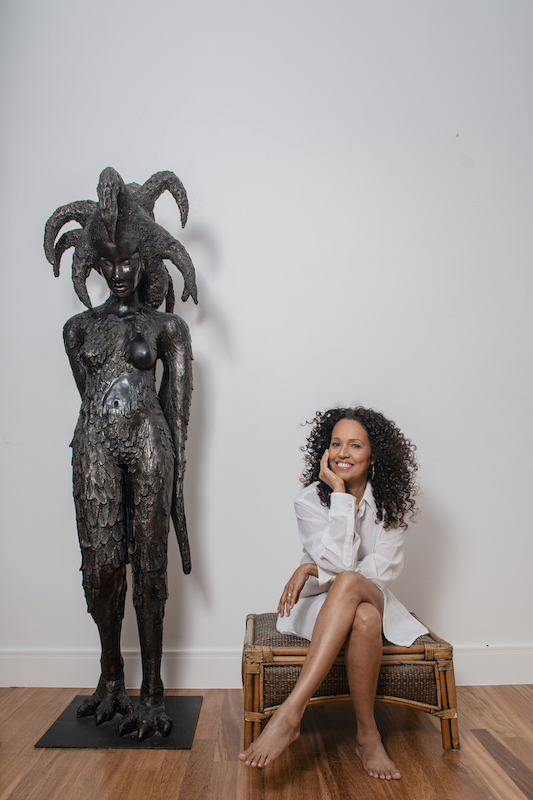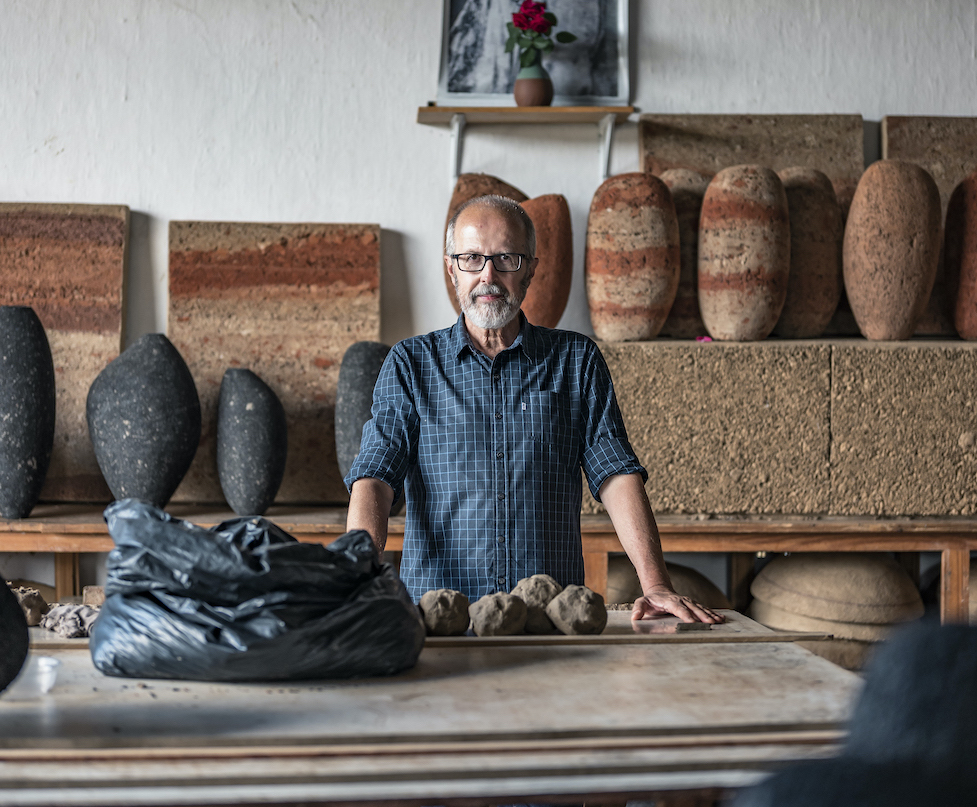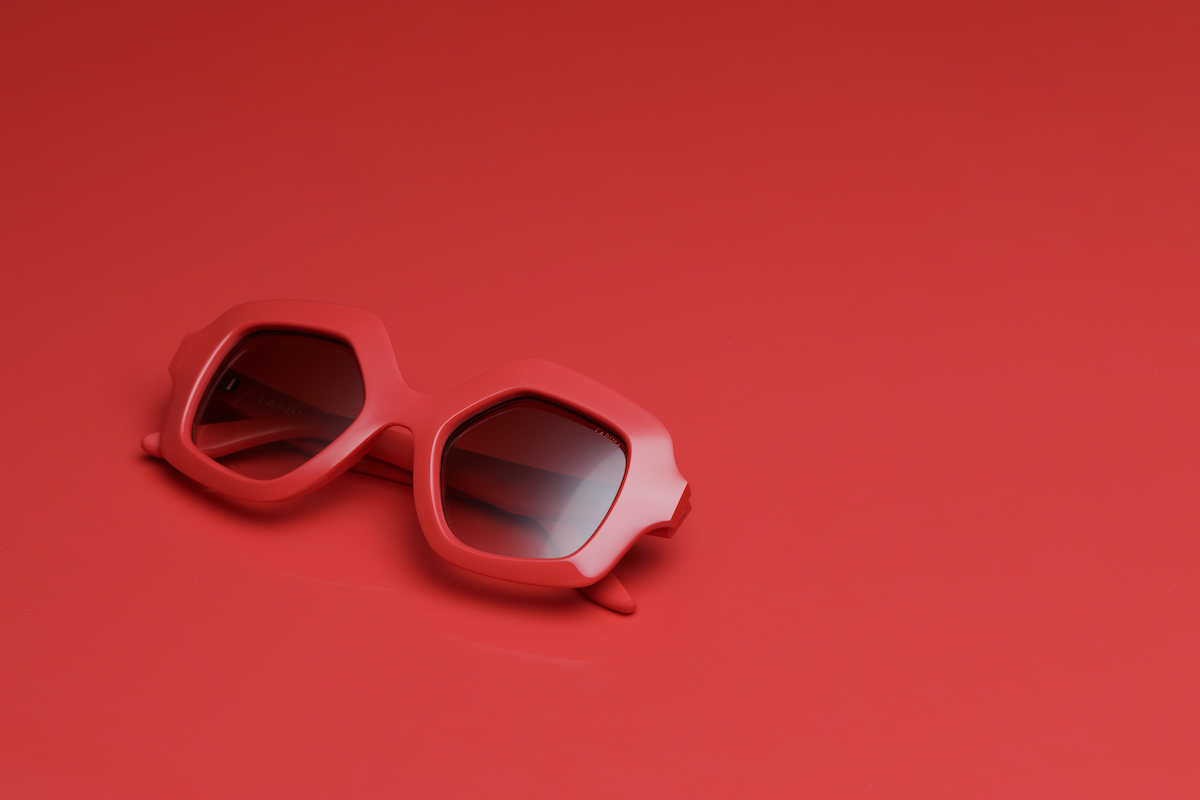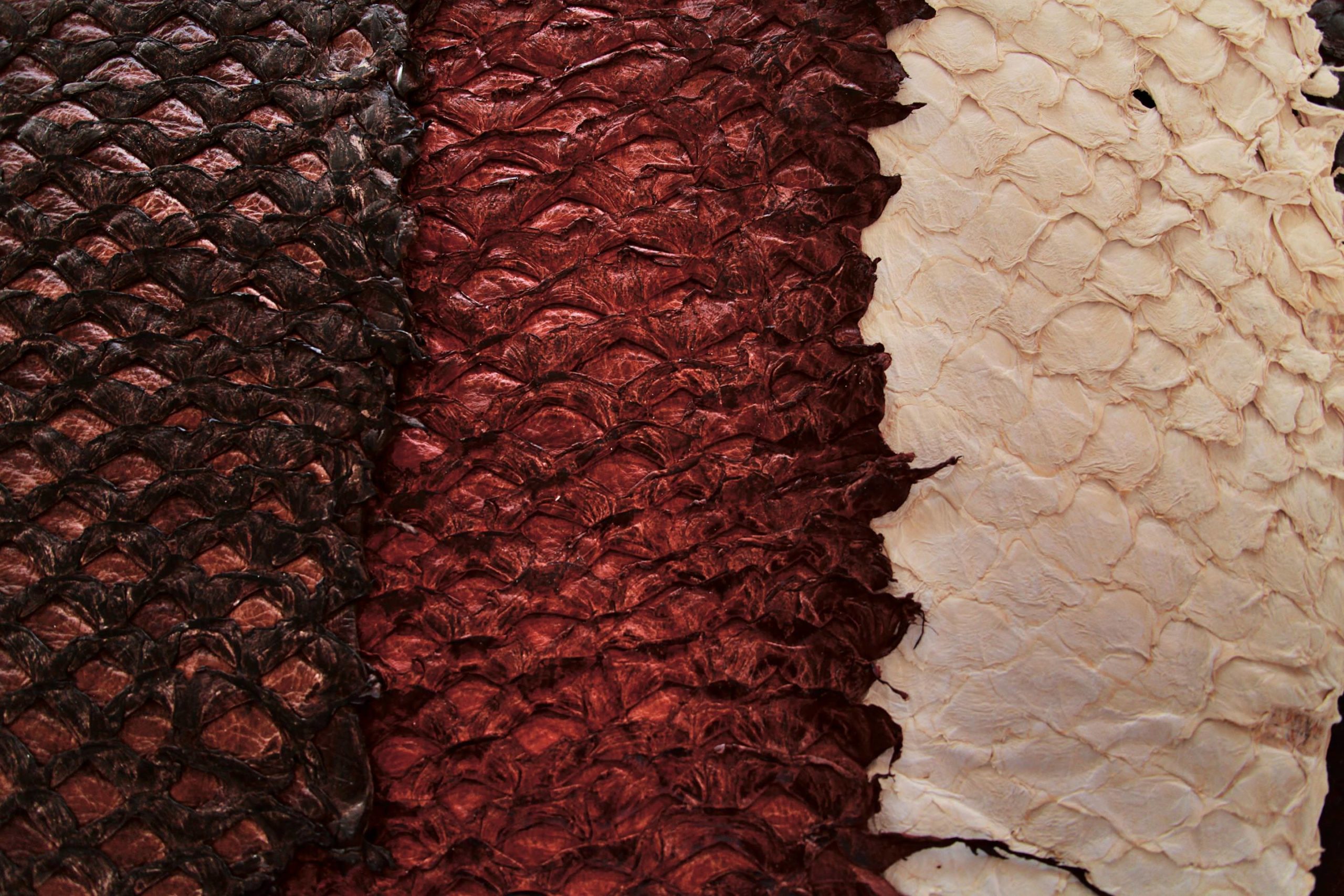Constructing new, living artifacts of African culture
The creative building blocks of Nádia Taquary’s artistic practice lie within the realm of ancestral traditions, history, and an exploration of Afro-Brazilian culture and heritage. Taquary’s gorgeous objects and installations delve into her background and that of her home in Bahia, Brazil. The locale’s culturally rich landscape, heavily influenced by African cultures, is a thing of beauty when considering the dark history of colonialism that’s behind it—and for that reason, the artist finds it important to honor these histories and traditions by keeping them alive.
Taquary works with materials like gold, silver, shells, straw, beading, and repurposed wood, which she has taken from demolished colonial structures. Informed by research, she constructs objects and artifacts with historic and ancestral significance, often creating her own interpretation of traditional adornments and jewelry—as in the 2019 exhibition “Oriki: Bowing to the Head” at Bakehouse Art Complex in Miami. Captivated by her work, Whitewall spoke with Taquary to learn more about her practice and inspirations.
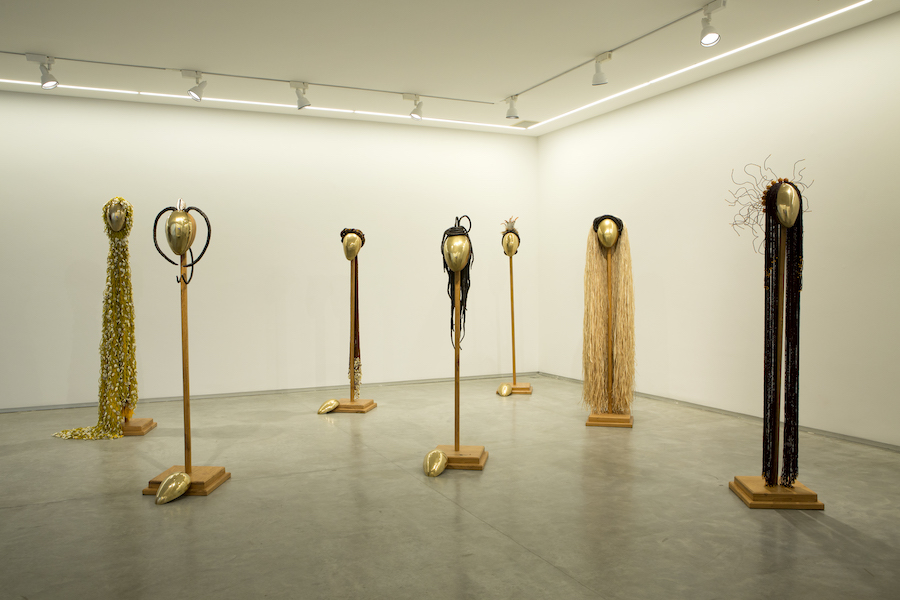
Installation view of Nadia Taquary’s “ìyàmì” (2021) at Paulo Darzé Galeria, photo by Marcio Lima, courtesy of the artist.
WHITEWALL: Take us back to your beginnings in art. When did you know you wanted to be an artist?
NÁDIA TAQUARY: To be an artist was never a wish or a choice. I majored in literature and did my graduate degree in education. However, the deep interest that sprang from my childhood memories of Afro-Brazilian jewelry that belonged to my father, a heritage from his grandmother, these memories led me to research this specific type of jewelry created and used by Black women in colonial Bahia.
My research on the history of this Afro-Brazilian jewelry—which is directly linked to the protagonist role of Black women, empowerment and freedom, the symbols and signs involving an entire mythology, and its connection with religiosity and identity—led me directly to the creation of my first work, entitled Abre Caminhos (“paths clearer”). This first work triggered a process that kept unfolding and led me to become an artist.
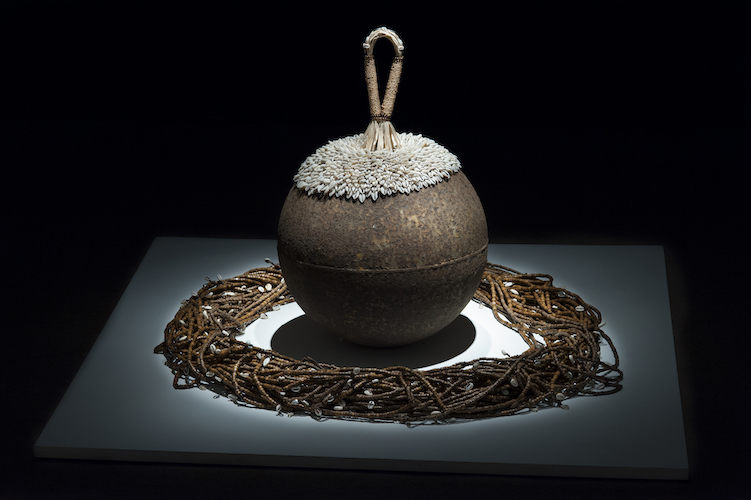
Nadia Taquary, “Mundo/Ifá,” 2013, old iron ball, shell, cowrie shells, coastal shore straw, and wood beads; photo by Andrew Kemp, courtesy of the artist.
WW: When did you first become interested in exploring Afro-Brazilian heritage and history?
NT: By being born in Bahia, in the city of Salvador, and by growing up on the Palm Coast, where all this cultural bulge reverberates, it was impossible for me not to be in touch with these traditions and to be positively affected by its multiple manifestations.
To be able to deepen my understanding of this heritage from Africa is to recognize the importance of this history, denied by racism, and also a way to understand myself and the political nature of my work.
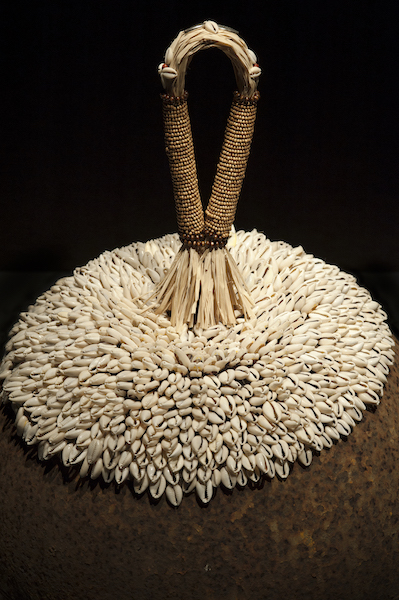
Nadia Taquary, “Mundo/Ifá (detail),” 2013, old iron ball, shell, cowrie shells, coastal shore straw, and wood beads; photo by Andrew Kemp, courtesy of the artist.
WW: Can you tell us about your creative practice? How does research inform your work?
NT: The first thing I notice when I reflect on my work process is how it is tied to the sacred, to the feeling of belonging and identity, and to this collectivity related to the sacred. This connection could not be different since, according to the traditional African art that informs my work, everything is related. The “Aiyê” and the “Orum” (the spiritual and the material world) are closely intertwined.
My creative process often happens intuitively. It usually starts with a glimpse of images’ fragments, often triggered by experiences with sacred practices of my tradition that keep reverberating in me, but it might also be prompted by insights that occur during an ordinary daily activity.
When these glimpses occur, I try to self-introspect and naturally let “what is to come” reveal itself to me. Once I understand what the artwork is about, I start researching it to deepen my knowledge around it, and from there I make more conscious decisions about the choice of material, shape, volume, and colors, translating as close as possible to the essence of the artwork that wants to be revealed.
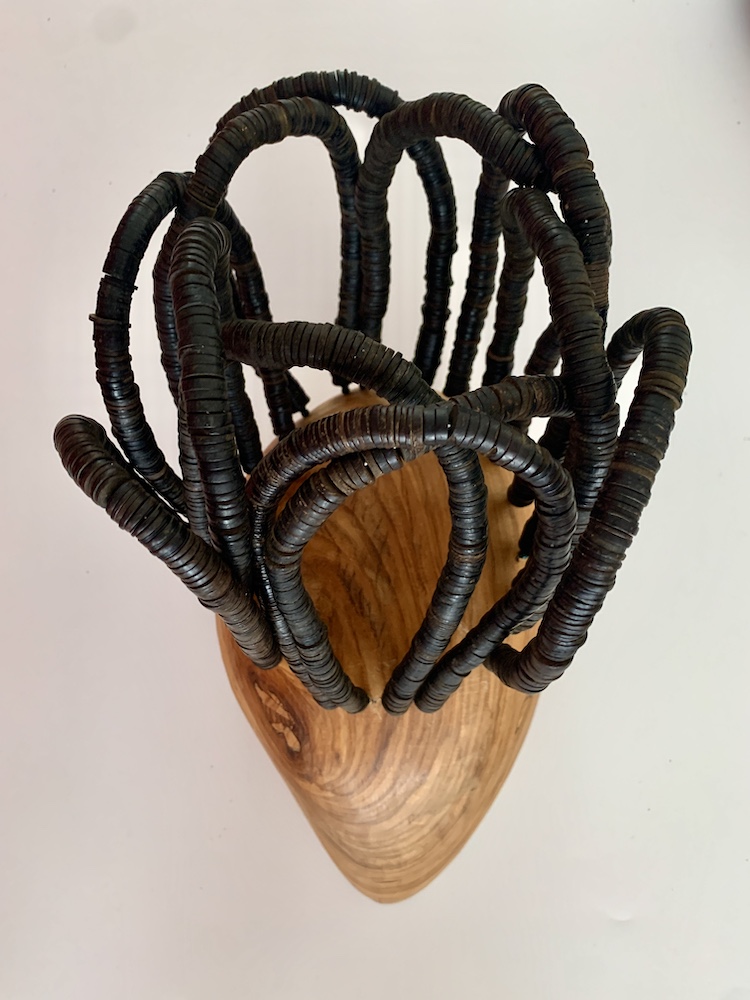
Nadia Taquary, “Oriki Ojeikere 02,” photo by and courtesy of the artist.
WW: Many of your sculptural objects are informed by Afro-Brazilian jewelry. Tell us how these works honor their point of inspiration. Where do you draw the line between appropriation and re-creation?
NT: I brought Afro-Brazilian jewelry into my work to draw attention to its history, aiming to displace it from a reductionist commercial context, which showed only a poor echo of what this art was. Based on this critical vision, my artwork interprets that tradition’s universes and cultural signs entangled for many centuries that refer to historical issues and the struggles for Black references in Brazil.
The Afro-Brazilian jewelry embodies all the complexity of our history. To bring it to the present time is to allow the spotlight on all the history that goes through it but does not end in it. When I brought Afro-Brazilian jewelry to my work, I tried to resituate it as an object that translates much of what we are: a symbol of resistance, overcoming, empowerment, and freedom.
Appropriation causes the hollowing of the latent history in these objects. Re-creation promotes understanding and updating of the importance of history.
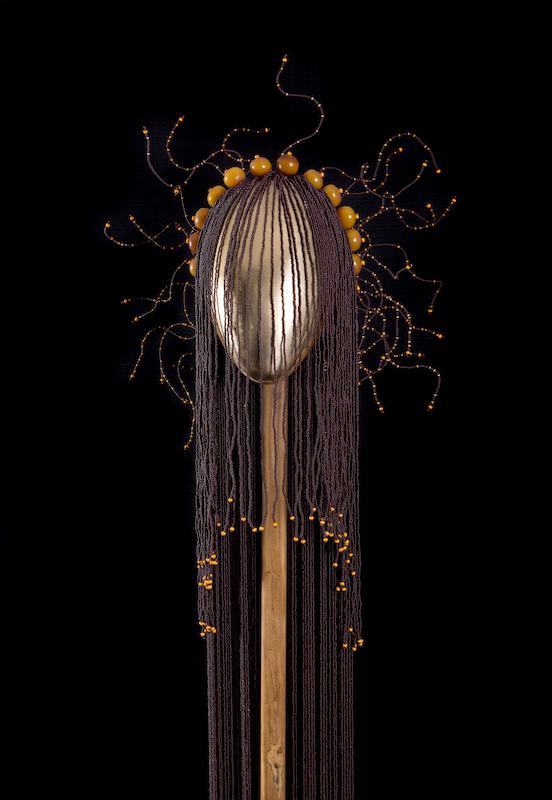
Installation view of Nadia Taquary’s “ìyàmì” (2021) at Paulo Darzé Galeria, photo by Marcio Lima, courtesy of the artist.
“The Afro-Brazilian jewelry embodies all the complexity of our history.”
WW: What is the significance of the materials—like wood, beads, straw, and metal—used in your works? Are they always informed by tradition?
NT: Yes, each material chosen intends great meaning. Nothing in my work is by chance, just like in traditional African art that informs me. No choice of color, no symbol, no form, no bead, and no element is without a purpose. Nothing is without a tie to the tradition it is speaking to.
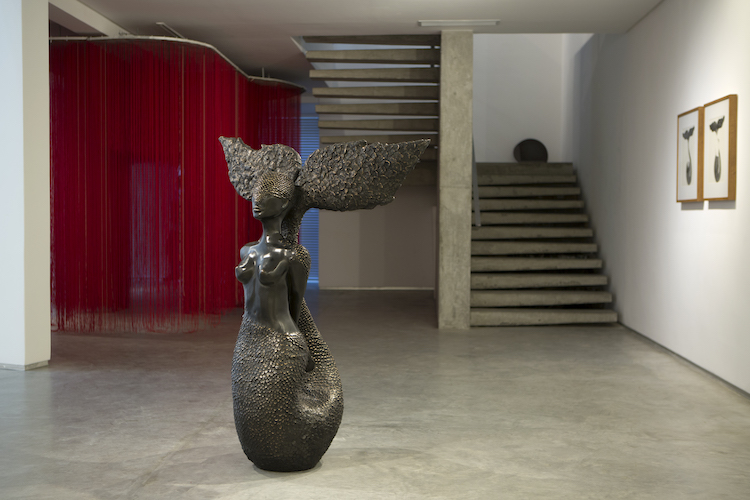
Installation view of Nadia Taquary’s “ìyàmì” (2021) at Paulo Darzé Galeria, photo by Marcio Lima, courtesy of the artist.
WW: One of the materials you use, Ipe wood, is repurposed from demolished colonial houses. This choice makes a statement on history and purpose, but it’s also an eco-conscious decision. How would you describe the relationship between tradition and history with ideas of environmental responsibility and sustainability?
NT: The choice of Ipe, a Brazilian wood often present in the structures of colonial houses, has a specific meaning in my work. It alludes to the long history of extractivism of natural resources and still a central issue of our time, as well as to the conscious use of this material that I repurpose to shape the heads created in the “Oriki: Bowing to the Head” series, acknowledging the ancestral past that sustains me.
When I reuse the material of these demolished structures, metaphorically, I am proposing to demolish thought structures rooted in perverse racial and patriarchal concepts that urgently need to be transmuted. To create the new through what already exists is to shed light on the unresolved social aspects of history urging for resolution.
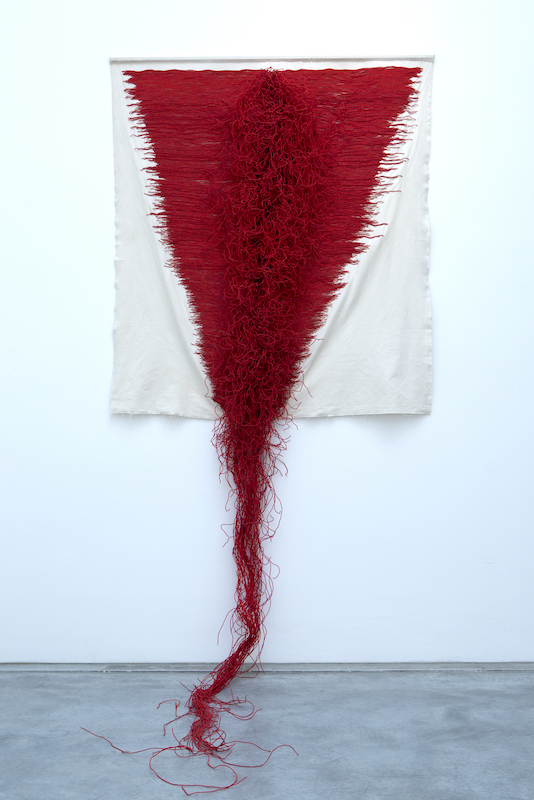
Installation view of Nadia Taquary’s “ìyàmì” (2021) at Paulo Darzé Galeria, photo by Marcio Lima, courtesy of the artist.


